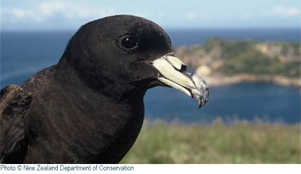The following news of a field trip after ACAP-listed Black or Parkinson’s Petrels Procellaria parkinsoni in New Zealand sent to ACAP Latest News comes from Janice Molloy of the Southern Seabird Solutions Trust.
Right now there is plenty of night-time activity on top of Mount Hobson, Great Barrier Island. Black Petrel chicks, with new glossy adult feathers, are coming out of their nest burrows and furiously flapping their wings. When they feel strong they waddle to a prominent rock and launch themselves, flying off, towards South America. They stay at sea around Ecuador and Peru for three or so years before they come back to Mt Hobson, find a mate and nest.
At this time of year the Black Petrel breeding cycle is almost complete. In late November each pair of breeding adults lays one egg in a burrow that the male digs and both parents raise the chick. Black Petrels are present in the Hauraki Gulf area from October through to May.

Black Petrel. Photograph by the New Zealand Department of Conservation
Black Petrels used to breed on high points throughout the North Island, and top of the South Island, often flying far inland to nest. They played an important role in the forest introducing rich nutrients into the ecosystem. Their droppings, eggshells, and dead chicks were deposited in the forest and they aerated the soil with their digging, acting like little composters.
This annual foray inland went on for millions of years. After the arrival of people the mainland colonies slowly disappeared as habitat destruction and predation by rats, cats, stoats, and pigs got the better of them. There are now about 15 000 Black Petrels left in the world, and of these only around 2000 breeding pairs. Most nest on Mt Hobson with a few nesting on Little Barrier Island.
Whitianga and Leigh longline fishermen Adam Clow, Wayne Dreadon, Gavin Perry, Clayton White, Mark Dellow, along with Leigh Fisheries employee Angela Cole and boat builder Mitch Pascoe, recently joined Biz Bell, seabird researcher, on top of Mt Hobson to help band Black Petrels before they flew off.
“Five minutes after meeting Biz I was up to my armpit in a Black Petrel burrow, carefully pulling a bird out then holding it while she banded it.” Gavin says.
“They’re smart birds and have an extraordinary homing sense. On land the path they use is like a bird highway at night, as Black Petrels from nearby burrows waddle to the rock they take-off from. After the chicks have left for South America the parent birds fly there, too, and, the following spring, they fly back to their burrows and meet the same old partner.”
It was also an amazing day for Adam. “The biggest thing for me was the realisation of how special and smart these birds are and how rare they are. I learned that they have a low survival rate and that fishermen here and South America play a part in their decline.”

Wayne Dreadon holds a Black Petrel. Photograph by Bruce Foster
Gavin says that no fishermen like catching birds and he and others in his fleet follow the Leigh Commercial Fishermen's Code of Practice, developed by Leigh fishermen over 20 years ago.
Wayne, Adam and Gavin agree the danger time is when they’re setting gear before dawn and birds want to dive on the baited hooks. They use tori [bird-scaring] lines to keep the birds out of the danger zone and weights to sink the baited hooks fast so the birds won’t dive on them. They make sure the deck lights point inwards to minimise the visual presence of the boat at sea. And they hold scraps onboard when there are hooks in the water – tipping a bucket of fish scraps overboard is like a dinner gong for seabirds.
“This experience hammered-in the vulnerability of these birds and their importance as a species. It gave me a totally new respect for them. It would be great if all fishermen did this trip to the colony at least once,” Gavin says.
“Our fleet has been aware of the risk to seabirds for many years and we will continue to do our bit to protect them, and to help others. A few years back a Leigh fisherman went to Peru to talk to fishermen over there about ways to avoid catching seabirds.”
Wayne agrees that helping band Black Petrels was a primo experience. “Watching them waddle to their take-off rock and fly off, into the night, was a primeval experience. These birds have been doing this, from this place, for thousands of years. All fishermen are obligated to work as a team to look after Black Petrels so they will continue to have a place, here, for thousands of years to come.”
Aotearoa Fisheries Ltd, Leigh Commercial Fishermen’s Association, Leigh Fisheries Ltd, Whitianga/Coromandel Peninsula Commercial Fishermen's Association, and Fisheries Inshore NZ have sponsored the production of a DVD of the fishermen’s Great Barrier experience. This will be available at www.southernseabirds.org.
Southern Seabird Solutions Trust is an alliance including representatives from the seafood industry, New Zealand government, WWF and Te Ohu Kaimoana that takes a cooperative approach to seabird conservation.
Click here to view the SSST’s profile of the Black Petrel.
With thanks to Janice Molloy.
John Cooper, ACAP Information Officer, 26 May 2013

 English
English  Français
Français  Español
Español